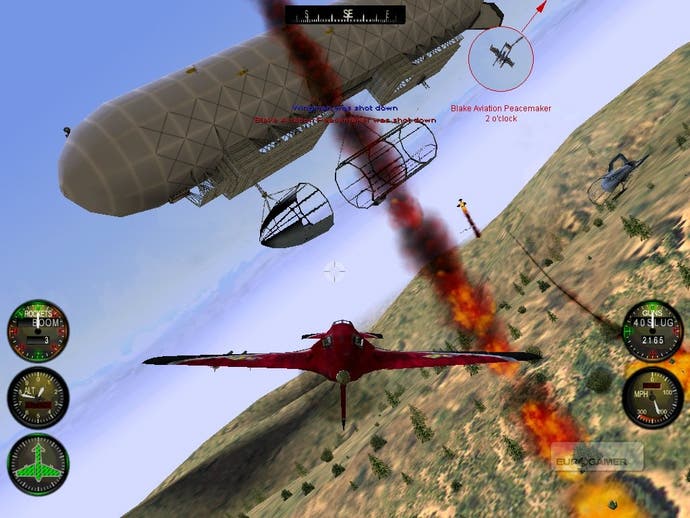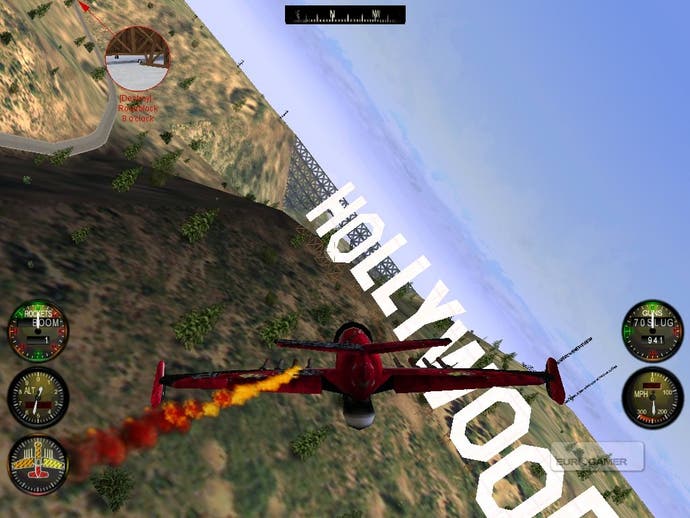Retrospective: Crimson Skies
Gorgeous planes and dangerous dames.
Ah yes, customisation. Assuming you've got the mission-generated cash to spare, all of Crimson Skies' fleet can be adapted to suit different tasks or combat styles. Need a bit of extra pace to keep up with the Black Swan's Furies? Trim some of the weapons from a stock Devastator and whack in a nitro-boosted 600hp power plant. Want to make the Bloodhawk acquired in the last sortie a tad more resistant to flak and frontal attacks? Unbolt some hardpoints and fit a bit more steel plate in the nose. And once the work is complete, why not take advantage of the simple yet flexible paint interface and give your new design a personalised livery.
The most whimsical opportunity for tinkering in the game has to be the period pin-ups that adorn load and hangar screens. As you traverse the campaign you amass a growing pile of titillating-yet-tasteful glamour pics - presents from various grateful thirties femmes. Paste one of these in the appropriate frame and you can admire it while you're waiting for the next sortie to start. Don't like ogling scantily-clad ladies? Fret not, there's a few shots of Nathan and his cute pet Labrador available too.
It's high time I mentioned the high drama that permeates every part of Crimson Skies' generously proportioned campaign. Far too many of the folk fashioning missions for today's light flight titles seem to think we gamers have to be shooting something down or blowing something up every 10 seconds to be enjoying ourselves. Zipper's scenario makers had a far more mature approach.

On a good day you might nail a dozen bandits, but usually bags are lower, and objectives far more interesting than simple bogey culls. During the 24-stage story sequence, Nathan dogfights, duels with rival aces, competes in races, performs recon, and grabs passengers from the cabooses of moving trains. There's hangars to be barnstormed, ground targets to be trashed, and planes in need of pinching. Best of all, there are numerous enemy dirigibles waiting, like huge heavenly cucumbers, to be plucked from the blue.
The zeps are probably the best thing in Crimson Skies. At the risk of exciting my analyst, I love the way they look. (The Russian 'Vostok' - a matt-black monster with a huge hammer-and-sickle emblazoned on its flank - is a particular favourite.) I love the way they nose out of cloud banks, massive, majestic and strangely herbivorous. The way they drop fighters vertically from their holds at the start of sorties, then catch them on special recovery hooks at the end. Most of all I love how they burn and slump when raked with rockets and hot lead. Not that you're always out to eviscerate them. In several sorties, hostile leviathans must be disabled with delicate shots to engine nacelles.

Airships also play a part in alleviating that perennial flight sim problem - the topographical blandness of sky. In furballs you regularly find yourself using them as cover, spiralling round them in eager pursuits and desperate evasions. When you're not dancing amongst the zeps or plunging in and out of fluffy clouds, spectacular ground scenery helps keeps the aviation interesting. Venues for the campaign's various capers include a Hawaiian island, a pirate city perched on the side of a mountain range, and the scenery-strewn back lots of Hollywood. Considering the simplicity of the underlying terrain mesh, and the lack of scenery shadows and fancy reflective water effects, Crimson Skies' landscapes are still surprisingly presentable.
Assuming you aren't viewing them via an ATI video card, that is. Thanks to the skill and industry of a friendly fellow called Timeslip, NVIDIA-equipped players have recently been able to enjoy this never-bettered aerial gem free from the graphical corruption that dogged it for years. Unfortunate Radeon folk, however, may still experience problems.